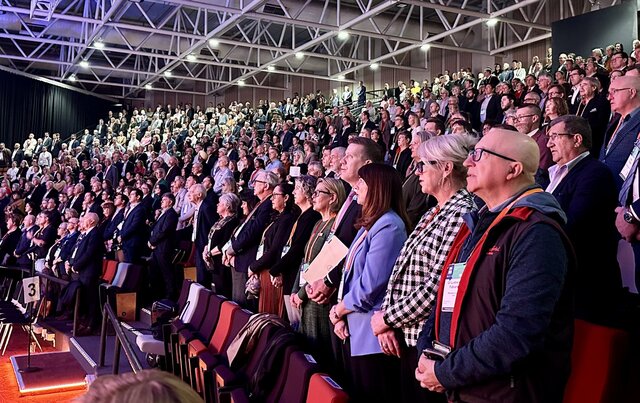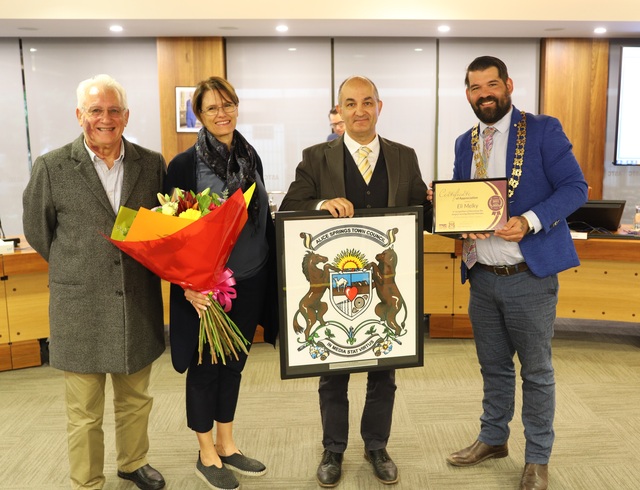Mayor Jenny Hill, Townsville City Council, Queensland
I’ve served on Townsville City Council since 1997. A friend of mine was Mayor at the time and he invited me to join his team. I’ve always been actively involved in the local community so joining Council gave me an opportunity to both extend and formalise that involvement.
My professional background is in microbiology. After studying at La Trobe University, I worked for the Department of Primary Industries, James Cook University, and Queensland Health (Townsville Hospital). My training as a scientist has given me a strong discipline; I am no stranger to long hours, service to the community, and attention to detail.
I’ve also spent many years in the Army Reserve. In 1987, I undertook training as an officer and became a lieutenant. Being in the Army Reserve has pushed me to do things I would never otherwise have done and has taught me to fear nothing.
Townsville past & present
Townsville City was gazetted in 1866, primarily as a seaport for the burgeoning cattle industry. It developed rapidly after the northern gold rush of the 1880s and then the establishment of the sugar cane industry. In World War Two it was integral as an Allies’ base against the Japanese. Today, the military presence remains strong, with the Third Brigade being Australia’s ready deployment force.
Townsville is now recognised as the commercial hub of North Queensland, due to its population currently exceeding 191,000 (it is expected to reach over 240,000 by 2021), a record of strong economic growth, proximity to major projects and diverse and growing industries. With almost $56 billion worth of projects in the development pipeline, capital investment in the region remains strong.
Townsville is also a leader in research and education, being home to James Cook University, the Australian Institute of Marine Science, and the Great Barrier Reef Marine Park Authority.
300 days of sun
The city has much to offer both local residents and visitors, being located within the dry tropics, and with the Great Barrier Reef, rainforest and outback all within easy travelling distance. Two of these attractions are listed as World Heritage Areas.
For 10 months of the year, we have the most wonderful weather – there’s nothing better than 300 days of sunshine! We also have great beaches, where you can make the most of the glorious weather, and Townsville residents are the most fantastic people.
Challenges for Townsville
Infrastructure is one of our biggest challenges in Townsville. During last year’s census period, our growth rate was 11 percent, while Queensland’s was eight percent. So, as with all growing communities, we still need to maintain our level of services. We’re also contending with the boom-and-bust economic cycle associated with all the resources on our doorstep. We’re enjoying the boom but we also need to make provision for leaner times.
As a council, we are currently undertaking our largest road reconstruction program on record. A total $150 million in National Disaster Relief and Recovery Arrangements(NDRRA) and capital renewal is being spent on restoring the city’s road network after two big wet seasons, including Cyclone Yasi.
In addition, we are revising our city plan, consolidating it into one comprehensive document that will see us through this unprecedented period of growth. We are also focusing on CBD renewal, which is experiencing significant success.
Leading in reconciliation
We have been a leader in Indigenous reconciliation for some time. In the 1980s, Townsville formally adopted an Indigenous employment policy, which resulted in us being the first council in Queensland to have an Indigenous Liaison Officer.
This staff member, along with others across our council business, is currently engaged in formulating our Reconciliation Action Plan, which aims to improve the relationship, respect and opportunities for Aboriginal and Torres Strait Islander peoples in Townsville.
Indigenous people make up more than six percent of our population – our traditional owners are the Wulgurukaba, Bindal and Nywaigi peoples – and we are committed to including them in our vibrant and prosperous city.
The future for Townsville
Townsville has the potential to become the capital of northern Australia — a preeminent financial centre, a mining hub, and (with the rollout of the NBN), a leader in the digital economy. However, to achieve this we need the right infrastructure: improved rail links, a base-load power station, and an expanded port.
As Mayor, I am focused on the long-term economic sustainability of the city, as well as the strength of our community. I want Townsville to be a place where my children, who are young adults, would want to return, pursue their careers and family lives, and live happily.
Mayor Denis Cook, Murweh Shire Council, Queensland
I was born and bred in Charleville and my family had two large businesses in town – one was a department store that carried everything and employed 24 staff; the other was a menswear and dry-cleaning business.
I was educated at St Mary’s School in Charleville, and then went to secondary school at Downlands College in Toowoomba.
After leaving school I worked at Bayards Department Store on Queen Street in Brisbane for a few years, where I used to catch a tram to the city. Sadly, trams in Brisbane are now a thing of the past.
I returned to Charleville in 1968 and worked at the family store for 30 years, which is where I learnt my people skills and how to listen to the general public.
On the closure of the store I got a job with Queensland Health at the local hospital, where I was employed as a wardsperson/carer for the next 15 years — a job that gave me great satisfaction and taught me to care for people.
I was first elected to Murweh Shire Council in 1991 and I’m now in my 22nd year, having been successful in seven elections.
I originally decided to run for Council following the massive floods in 1990, when Charleville was destroyed. I wanted to find ways to protect the town against future floods, as it is built on the banks of the Warrego River, and Bradley’s Gully runs right through the town centre.
About Murweh Shire
Murweh Shire covers 43,905km2 on the Great Artesian Basin and includes the towns of Augathella, Charleville, Cooladdi and Morven. The population of the Shire is approximately 5000.
The Shire is at the centre of a rich pastoral district carrying some 800,000 sheep and 100,000 cattle. Charleville is the major service centre for the cattle and sheep industries in the region and is moving ahead following the nation-wide decline in the rural industries.
Challenges for Charleville
Charleville has experienced three more floods since 1990 and a multi-million dollar levee now protects the town from the river, but Bradley’s Gully still poses a problem for the town. However, as we speak, a $14 million gully diversion is underway and nearing completion, and at last Charleville should be flood-proof.
Health is another big challenge for the region, as our one-and-only private GP is retiring in December of 2013.
Charleville has a brand new medical centre, which was built in 2009, but no doctors. We also had a new dentistry centre and no dentists. Now, however, and as a result of extremely hard work by Council, we have two private dentists in our centre, which saves the public a five-hour trip to Roma.
In the New Year we will also have three private doctors from the Royal Flying Doctor Service (RFDS) operating out of the medical centre, which will also save the town folk from having to travel to other centres for medical treatment.
Current projects and future plans
Murweh Shire Council is currently working on the development of an arts and crafts centre, with an art gallery at the front and the other half of the building providing a cultural centre for crafts of all types. At present, our local craft group has over 60 members.
We are also working on the restoration of our historic town hall and we’re in the process of developing some major tourism projects to fit in with our Cosmos Centre & Observatory, which opened in 2003 and provides a not-to-be-missed experience of the Milky Way and the outback night sky.
For the future, I want to work towards providing the people of the Murweh Shire with the range of services that city people take for granted, such as medical services, safe roads, water and a hassle-free lifestyle.
I’d like to make Murweh Shire a great place to live and retire, boosting the economy through tourism and eventually having a controlled level of mining in the region. We need to make it affordable for ordinary people to live and work in this great Shire.
Being Mayor of Murweh
The most difficult part of my role as Mayor is the travel. Given the size of Murweh Shire, it can take up to five hours of travel to attend meetings.
I get some of the best advice about my role each morning, while waiting for the newspaper to be delivered by road, where I join the locals who are also waiting for their papers. It is here that I get plenty of advice on what Council is doing right or wrong, and what they think is relevant to my role.
Following my time as Mayor of Murweh Shire I hope to be remembered as somebody who got things done; as somebody who listened to what the people wanted; and as somebody who helped to make Murweh a safe and friendly place, with a fine range of health, education and modern facilities.







